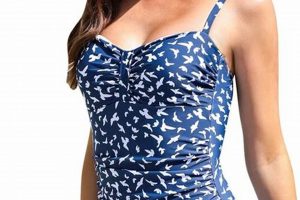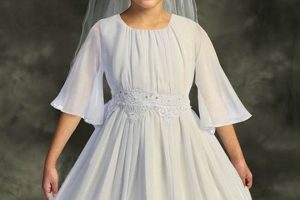Garments characterized by botanical designs rendered on fabric, crafted in earlier eras, evoke a sense of nostalgia and timelessness. These articles of clothing, often dating from the 1920s to the 1970s, showcase a diverse range of floral motifs, silhouettes, and construction techniques that reflect the stylistic preferences of their respective periods. For instance, a rayon tea dress from the 1940s adorned with delicate rose patterns exemplifies this category.
The enduring appeal of these items lies in their unique aesthetic and historical significance. They represent a tangible link to bygone eras, offering wearers a chance to connect with the past. Furthermore, their inherent individuality stands in contrast to mass-produced contemporary fashion, providing a distinctive style statement. The resurgence of interest in sustainable practices also contributes to their value, promoting the reuse and appreciation of pre-owned apparel.
The subsequent sections will delve into specific aspects, including the identification of authentic examples, preservation techniques, and the integration of these distinctive pieces into contemporary wardrobes.
Guidance on Acquiring and Maintaining Garments with Botanical and Period Characteristics
The following recommendations provide insight into the selection, preservation, and display of apparel showcasing both historical construction and plant-inspired designs.
Tip 1: Authenticate the Era: Examination of construction techniques, fabric composition (natural versus synthetic fibers), and label information is crucial. Research typical silhouettes and materials for each decade to verify the piece’s provenance. For example, bias-cut rayon dresses are indicative of the 1930s.
Tip 2: Assess Condition Carefully: Prioritize items with minimal damage. Check for stains, tears, weakened seams, and fabric deterioration due to age or improper storage. Moth damage, particularly in natural fibers, significantly reduces value and wearability.
Tip 3: Understand Fabric Care Requirements: Antique fabrics often require specialized cleaning. Silk and rayon typically necessitate professional dry cleaning, while cotton may be hand-washed with gentle detergents. Always test a small, inconspicuous area first.
Tip 4: Store Appropriately: Protect against light, moisture, and pests. Use padded hangers to maintain shape and acid-free tissue paper to prevent creases. Consider garment bags made of breathable materials like muslin.
Tip 5: Repair Strategically: Minor repairs, such as reinforcing seams or replacing missing buttons, can extend the life of the garment. Consult a professional restorer for significant damage or alterations that may impact the item’s historical integrity.
Tip 6: Consider Display Options: When not worn, these garments can serve as decorative objects. Mount on mannequins in controlled environments, or frame small sections of fabric to preserve and showcase their aesthetic qualities.
These practices will ensure the longevity and continued enjoyment of these sartorial artifacts.
The subsequent sections will provide further information on the integration of these articles into contemporary fashion ensembles.
1. Era Authenticity
The era of origin significantly impacts the characteristics, value, and wearability of attire displaying botanical designs. Establishing the authenticity of the period is critical to understanding the garment’s construction, materials, and design aesthetics. An incorrect attribution can lead to improper care, diminished value, and a misrepresentation of historical fashion trends. For example, a dress misidentified as being from the 1930s, when it is actually from the 1950s, may be subjected to cleaning methods unsuitable for its actual fabric composition, potentially causing irreversible damage.
Era authenticity influences not only the physical attributes but also the social and cultural context. Dresses from the 1940s, often characterized by floral prints on rayon or cotton, reflect wartime austerity and practical design. In contrast, pieces from the 1960s, frequently featuring bolder floral patterns and synthetic fabrics, embody the era’s spirit of experimentation and liberation. The silhouette, detailing, and even the specific type of floral motif (e.g., Art Deco versus psychedelic) serve as markers of the period. Thus, accurate identification allows for a deeper appreciation of the garment as a product of its time. This identification often requires expert assessment, as mass manufacturing of reproductions obfuscates clear identification, and the same floral print can be adapted to a very different style of cut in different eras.
Challenges in determining era authenticity include the absence of labels, alterations that obscure original features, and the reuse of fabrics across decades. Despite these difficulties, meticulous examination of construction techniques, fabric composition, and stylistic details provides a foundation for accurate dating. Understanding the practical implications of era authentication allows collectors and enthusiasts to preserve historical garments effectively and appreciate their place within the broader narrative of fashion history. Without this understanding, the nuances and significance of such pieces are effectively lost or misrepresented, leading to a devaluation of these historical pieces.
2. Fabric Identification
Fabric identification is a critical component in the authentication, preservation, and appropriate care of apparel adorned with botanical designs from prior eras. The composition of the textile directly influences its fragility, cleaning requirements, and susceptibility to damage. Misidentification can lead to irreversible harm, such as shrinkage, color loss, or fiber degradation. For instance, a rayon dress, often mistaken for silk due to its sheen, may be subjected to cleaning methods too harsh for its delicate fibers, resulting in structural damage. Conversely, assuming a garment is cotton when it is, in fact, linen may lead to excessive shrinkage during washing.
The textile also provides crucial clues to the age and origin of the garment. Prior to the widespread adoption of synthetic fibers, natural materials such as cotton, linen, wool, and silk were prevalent. The type of fiber, weave structure, and any applied finishes are indicative of the period in which the fabric was manufactured. A floral piece from the 1930s is likely to be constructed from rayon or cotton, while a similar piece from the 1960s might incorporate polyester or nylon blends. The use of specific dyes and printing techniques also offers further insight into the era of production. For example, the presence of certain synthetic dyes can definitively place a garment after a specific date. Moreover, the fabrics texture, drape, and resilience are intrinsic to the overall aesthetic and silhouette of the attire. A heavy brocade will lend itself to structured designs, while a lightweight chiffon will allow for flowing, ethereal styles.
In summary, accurate fabric identification is indispensable for anyone involved in collecting, preserving, or wearing antique attire showcasing botanical patterns. Proper identification protects the garment from damage, facilitates informed purchasing decisions, and provides valuable clues to its age and provenance. The ability to discern between different fiber types and manufacturing techniques empowers enthusiasts to maintain these garments appropriately and to appreciate their historical significance. The practical implications of neglecting fabric identification may result in irreparable damage to valuable artifacts, thereby diminishing their inherent value and historical contribution.
3. Floral Patterns
The application of botanical motifs constitutes a defining characteristic of many garments from past decades, influencing aesthetic appeal, historical context, and perceived value. An understanding of the various styles, techniques, and cultural associations of these designs is essential for the appreciation and assessment of attire from previous eras.
- Motif Scale and Style
The size and rendering of floral elements impact the overall visual effect. Large-scale, bold prints are characteristic of the 1960s and 1970s, while smaller, more delicate designs are often found on items from the 1930s and 1940s. Stylistic interpretations range from realistic depictions to stylized, abstract forms, each reflecting the artistic trends of its time. For example, an Art Deco dress might feature geometric floral patterns, contrasting with the naturalistic roses found on a 1950s tea dress.
- Printing Techniques
The method of applying floral designs to fabric influences the pattern’s clarity, durability, and texture. Block printing, screen printing, and roller printing are among the techniques used throughout the 20th century. Each method yields distinct results, from the crisp lines of screen printing to the slightly imperfect, handmade quality of block printing. Identifying the printing technique can aid in dating the garment and understanding its manufacturing process.
- Color Palette and Dye Technology
The colors used in floral patterns are reflective of the available dyes and prevailing fashion trends. Early synthetic dyes introduced vibrant, saturated colors in the mid-20th century, expanding the palette beyond natural dyes. The color combinations and intensity contribute to the overall aesthetic and can be indicative of the garment’s era. For instance, pastel floral prints were popular in the 1950s, while bolder, psychedelic colors dominated the late 1960s and early 1970s.
- Cultural Significance
Floral motifs carry cultural associations that can influence the garment’s meaning and appeal. Certain flowers symbolize specific emotions or sentiments, while others are associated with particular events or social movements. For example, the rose is often linked to romance and femininity, while the daisy represents innocence and simplicity. Understanding these associations provides a deeper appreciation for the symbolic language of floral design.
In summary, the diverse characteristics of designs portraying flora are intrinsically linked to the appeal, value, and historical context of garments displaying botanical ornamentation. The interplay of motif scale, printing technique, color palette, and cultural significance contributes to a unique sartorial narrative that reflects the artistic and social trends of each era.
4. Silhouette Styles
The term “silhouette styles” within the context of garments from previous decades, adorned with plant-inspired designs, refers to the garment’s overall shape and form as it outlines the wearer’s figure. Silhouette styles are a crucial determinant of the garment’s aesthetic appeal, historical accuracy, and wearability. The cut and construction of a garment dictate how it drapes and fits, directly influencing its conformity to the fashion ideals of its time. For example, the drop-waist silhouette characteristic of the 1920s flapper dress contrasts sharply with the cinched-waist, full-skirted silhouette of the 1950s, reflecting the distinct social and aesthetic values of each era. The floral motifs are frequently designed to complement and enhance the silhouette; a large-scale floral print on a flowing 1970s maxi dress amplifies the bohemian aesthetic, whereas a delicate floral pattern on a tailored 1940s suit softens the wartime-inspired austerity. A mismatch between the floral pattern and silhouette can detract from the garment’s authenticity and overall visual harmony.
Consider the practical application of this understanding. A collector seeking to acquire an authentic 1930s garment featuring botanical ornamentation should recognize the bias-cut silhouette as a defining characteristic of that era. The fabric drapes fluidly, accentuating the body’s natural curves. Attempting to force this garment onto a modern body type that does not align with the intended silhouette may result in an unflattering or historically inaccurate representation. Similarly, a contemporary designer drawing inspiration from these historical garments must understand the relationship between the cut and the print to create a cohesive and aesthetically pleasing design. Understanding period appropriate undergarments and their interaction with the desired silhouette is also key to accurate representation. For example, modern bras may distort the lines of 1950s dresses created to be worn with specific cone shaped bras of the time. The application of modern styles to floral pieces changes the intended look and value.
In summary, “silhouette styles” are an indispensable component of the identification, appreciation, and preservation of garments displaying botanical aesthetics from prior decades. The silhouette not only defines the garment’s shape but also serves as a crucial indicator of its era, cultural context, and intended aesthetic impact. Careful consideration of silhouette style is essential for collectors, designers, and enthusiasts seeking to engage with these articles of clothing in a meaningful and historically accurate way. A comprehensive understanding reduces the likelihood of misidentification, improper care, and aesthetic misrepresentation, ensuring the enduring appreciation of these sartorial artifacts.
5. Construction Quality
The term “construction quality,” when applied to garments with botanical designs from previous eras, encompasses the materials, techniques, and craftsmanship employed in their creation. Construction quality directly influences a garment’s durability, longevity, and aesthetic appeal. Superior construction translates to increased resilience against wear and tear, ensuring the garment’s ability to withstand the passage of time and the stresses of handling and occasional use. Conversely, substandard construction leads to premature deterioration, rendering the piece unwearable and diminishing its historical value. For example, a dress from the 1930s with meticulously hand-stitched seams and reinforced stress points is more likely to survive in excellent condition compared to one mass-produced with poorly secured seams and flimsy fabric. The quality of the stitching, the finishing of the hems, and the selection of materials contribute significantly to the garment’s overall integrity and appearance.
Specific construction techniques, such as French seams, hand-rolled hems, and the use of high-quality interfacings, are indicative of superior craftsmanship. These details not only enhance the garment’s durability but also elevate its aesthetic appeal, adding a touch of refinement and sophistication. The proper execution of these techniques requires skilled labor and attention to detail, reflecting a commitment to quality over expediency. In the context of pieces featuring floral patterns, the alignment of the print across seams and closures demonstrates a high level of craftsmanship. Similarly, the secure application of embellishments, such as beads or embroidery, ensures that the design remains intact over time. A garment’s construction quality also provides insight into the manufacturing practices and social conditions of its era. Items made during periods of economic hardship may exhibit cost-saving measures, such as the use of lower-quality materials or simplified construction techniques, while those produced during times of prosperity may showcase more elaborate designs and intricate detailing. The integration of these elements shows a true piece.
In conclusion, construction quality serves as a critical factor in evaluating and appreciating apparel that is vintage and floral, influencing durability, aesthetics, and historical significance. A discerning assessment of construction techniques, materials, and craftsmanship allows collectors, designers, and enthusiasts to identify superior items, preserve them effectively, and understand their place within the broader narrative of fashion history. Ignoring construction quality risks investing in poorly made garments that are prone to damage and contribute little to the understanding or appreciation of sartorial evolution. The preservation and appreciation of pieces with botanical motifs hinges on the ability to recognize and value the elements of high-quality construction.
6. Preservation Methods
The longevity and integrity of floral attire from previous eras are inextricably linked to the preservation methods employed. These methods serve as a critical intervention to mitigate the effects of time, environmental factors, and inherent material vulnerabilities. Without appropriate preservation, the delicate fabrics, dyes, and embellishments characteristic of these pieces are susceptible to deterioration, leading to irreversible damage and the eventual loss of historical and aesthetic value. For example, exposure to ultraviolet light can cause fading and weakening of fabric fibers, while improper storage can lead to mold growth and insect infestation. The selection and execution of preservation techniques must therefore be tailored to the specific materials and construction of each garment.
Effective preservation encompasses a range of strategies, including careful cleaning, proper storage, and preventive maintenance. Delicate fabrics, such as silk and rayon, often require specialized dry cleaning or gentle hand washing with pH-neutral detergents. Storage should be in a cool, dry, and dark environment, utilizing acid-free tissue paper and padded hangers to prevent creases and distortion. Regular inspection for signs of damage, such as tears, stains, or pest activity, allows for timely intervention and prevents further deterioration. A dress from the 1950s, carefully preserved using these methods, can retain its original color and form for decades, serving as a tangible link to the past and a valuable resource for fashion historians and enthusiasts. Neglecting these strategies, however, can result in the rapid degradation of even the most exquisite garments, rendering them little more than fragile remnants of their former glory. Real-world examples include museum collections that employ sophisticated environmental controls and conservation techniques to safeguard their holdings, demonstrating the profound impact of proactive preservation measures.
In summary, preservation methods are not merely ancillary considerations but rather integral components in the lifecycle of floral attire from past decades. The diligent application of these techniques safeguards the physical integrity and aesthetic value of these garments, ensuring their continued accessibility for future generations. The challenges inherent in preserving delicate fabrics and intricate designs underscore the importance of specialized knowledge and meticulous attention to detail. By recognizing the causal relationship between preservation and longevity, collectors and enthusiasts can contribute to the broader goal of preserving fashion history and cultural heritage, maintaining these pieces as viable historic signifiers.
7. Wearability
The term “wearability,” in relation to attire displaying botanical designs from past eras, denotes the suitability of a garment for contemporary use, considering factors such as fit, condition, and style compatibility. Wearability is a crucial determinant of a garment’s practical value and appeal, influencing purchasing decisions and integration into modern wardrobes. A garment, regardless of its aesthetic qualities or historical significance, holds limited value if its physical state or design renders it impractical for everyday wear. For example, a dress with significant fabric deterioration, an unalterable and ill-fitting silhouette, or a style that clashes dramatically with current fashion trends may be deemed unwearable, relegated to display or archival purposes rather than practical use. The concept of wearability encompasses both physical condition and aesthetic relevance, requiring a nuanced evaluation that considers the garment’s inherent characteristics and the wearer’s individual needs and preferences. A 1950s sundress, carefully mended and altered to fit a contemporary body, may be highly wearable, whereas an identical dress with extensive staining or a rigid, unadjustable bodice may not be. A number of period silhouettes are difficult to work with modern body types.
Furthermore, wearability is not static; it evolves in response to changing fashion trends and cultural norms. A floral dress considered fashionable and wearable in one era may fall out of favor in another, only to be rediscovered and reintegrated into contemporary wardrobes at a later time. The resurgence of interest in garments from the 1970s, for instance, has led to the reevaluation of previously dismissed styles, highlighting the cyclical nature of fashion and the fluid definition of wearability. Wearability is also influenced by the wearer’s individual style and comfort level. While one person may embrace the distinctive silhouette and vintage charm of a 1940s floral tea dress, another may prefer a more streamlined and modern interpretation of botanical designs. Understanding the factors that contribute to wearability allows collectors, designers, and enthusiasts to make informed choices about acquiring, adapting, and incorporating garments from past decades into their present-day lives. In the practical application, one can see the blending of vintage fabric and style. A wearer can use a vintage floral scarf to bring vintage style to their wearability today, without a complete transformation.
In summary, wearability is a complex and multifaceted concept that encompasses the physical condition, aesthetic relevance, and individual preferences surrounding clothes adorned with plant life illustrations from prior decades. The assessment of wearability is not merely a subjective exercise but rather a pragmatic evaluation that influences value, purchasing decisions, and the integration of these items into modern fashion. The understanding of wearability is key to ensuring these styles remain viable and visible.
Frequently Asked Questions
The following questions address common inquiries and misconceptions regarding garments from past eras characterized by botanical designs.
Question 1: How can one distinguish between a genuine example and a reproduction?
Distinguishing between a genuine article and a reproduction requires careful examination. Key indicators include construction techniques (hand-stitching versus machine-stitching), fabric composition (natural fibers versus synthetic blends), and the presence of original labels or tags. Authentic examples often exhibit subtle imperfections indicative of their age and manufacturing processes.
Question 2: What are the primary concerns when cleaning antique fabrics?
The primary concerns when cleaning antique fabrics are fiber degradation, dye instability, and structural damage. Prior to any cleaning attempt, a small, inconspicuous area should be tested for colorfastness. Delicate fabrics, such as silk and rayon, typically necessitate professional dry cleaning or gentle hand washing with pH-neutral detergents.
Question 3: How does storage impact the longevity of these garments?
Improper storage can accelerate the deterioration of these garments. Exposure to light, moisture, and pests can cause fading, mold growth, and fiber damage. Storage in a cool, dry, dark environment, utilizing acid-free tissue paper and padded hangers, is recommended.
Question 4: What are the ethical considerations surrounding the acquisition of antique pieces?
Ethical considerations include verifying the garment’s provenance to ensure it was not obtained through illegal or exploitative means. Supporting reputable dealers and avoiding the purchase of items from questionable sources promotes responsible collecting practices.
Question 5: How can one integrate these styles into a contemporary wardrobe?
Integration into a contemporary wardrobe can be achieved through strategic styling. Pairing a garment with modern separates, incorporating contemporary accessories, and altering the fit to align with current silhouettes are effective methods.
Question 6: What resources are available for further research and authentication?
Resources for further research and authentication include fashion history books, online databases, museum collections, and expert appraisals. Consulting with reputable dealers and conservators provides access to specialized knowledge and professional guidance.
The preservation and appreciation of these garments require informed decision-making and a commitment to responsible collecting practices.
The subsequent sections will delve into related topics, expanding the scope of knowledge and understanding in the sector of clothing with botanical patterns.
Conclusion
Throughout this examination, the multifaceted nature of attire, characterized by botanical designs from prior decades, has been elucidated. The analysis encompassed aspects ranging from era authentication and fabric identification to silhouette styles, construction quality, preservation methods, and contemporary wearability. Each of these elements contributes significantly to the value, historical significance, and practical utility of these garments. This exploration aimed to foster a deeper understanding and appreciation for these items of sartorial history.
The preservation and study of artifacts displaying floral motifs represent an ongoing endeavor. Continued research, meticulous documentation, and responsible stewardship are essential to ensure their accessibility for future generations. The enduring legacy of garments with designs from flora can contribute significantly to the broader understanding of fashion history, social evolution, and cultural heritage.







